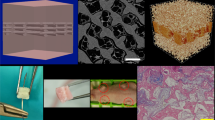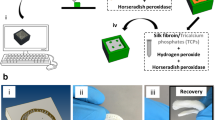Abstract
In this study, silk fibroin nanofibrous scaffolds were developed to investigate the attachment and proliferation of primary human meniscal cells. Silk fibroin (SF)–polyvinyl alcohol (PVA) blended electrospun nanofibrous scaffolds with different blend ratios (2:1, 3:1, and 4:1) were prepared. Morphology of the scaffolds was characterized using atomic force microscopy (AFM). The hybrid nanofibrous mats were crosslinked using 25 % (v/v) glutaraldehyde vapor. In degradation study, the crosslinked nanofiber showed slow degradation of 20 % on weight after 35 days of incubation in simulated body fluid (SBF). The scaffolds were characterized with suitable techniques for its functional groups, porosity, and swelling ratio. Among the nanofibers, 3:1 SF:PVA blend showed uniform morphology and fiber diameter. The blended scaffolds had fluid uptake and swelling ratio of 80 % and 458 ± 21 %, respectively. Primary meniscal cells isolated from surgical debris after meniscectomy were subcultured and seeded onto these hybrid nanofibrous scaffolds. Meniscal cell attachment studies confirmed that 3:1 SF:PVA nanofibrous scaffolds supported better cell attachment and growth. The DNA and collagen content increased significantly with 3:1 SF:PVA. These results clearly indicate that a blend of SF:PVA at 3:1 ratio is suitable for meniscus cell proliferation when compared to pure SF-PVA nanofibers.







Similar content being viewed by others
References
Abdal-hay A, Hussein KH, Casettari L, Khalil KA, Hamdy AS (2016) Fabrication of novel high performance ductile poly (lactic acid) nanofiber scaffold coated with poly (vinyl alcohol) for tissue engineering applications. Mater Sci Eng 60:143–150
Altman GH, Diaz F, Jakuba C, Calabro T, Horan RL, Chen J, Lu H, Richmond J, Kaplan DL (2003) Silk-based biomaterials. Biomaterials 24:401–416
Bhattacharjee P, Kundu B, Naskar D, Maiti TK, Bhattacharya D, Kundu SC (2015) Nanofibrous nonmulberry silk/PVA scaffold for osteoinduction and osseointegration. Biopolymers 103(5):271–284
Chambers MC, El-Amin SF (2015) Tissue engineering of the meniscus: scaffolds for meniscus repair and replacement. Musculoskelet Regen 1:e998
Chen X, Knight DP, Shao Z, Vollrath F (2001) Regenerated Bombyx silk solutions studied with rheometry and FTIR. Polymer 42:09969–09974
Chen X, Yin Z, Chen JL, Liu HH, Shen WL, Fang Z, Zhu T, Ji J, Ouyang HW, Zou XH (2014) Scleraxis-overexpressed human embryonic stem cell–derived mesenchymal stem cells for tendon tissue engineering with knitted silk-collagen scaffold. Tissue Eng Part A 20:1583–1592
Ghasemi-Mobarakeh L, Morshed Karbalaie K, Fesharaki Nasr-Esfahani MH, Baharvand H (2008) Electrospun poly (ε-caprolactone) nanofiber mat as extracellular matrix. Yakhteh Med J 10:179–184
Gittens RA, McLachlan T, Olivares-Navarrete R, Cai Y, Berner S, Tannenbaum R, Schwartz Z, Sandhage KH, Boyan BD (2011) The effects of combined micron-/submicron-scale surface roughness and nanoscale features on cell proliferation and differentiation. Biomaterials 32:3395–3403
Gopinathan J, Mano S, Elakkiya V, Pillai MM, Sahanand KS, Rai BKD, Selvakumar R, Bhattacharyya A (2015) Biomolecule incorporated poly-ε-caprolactone nanofibrous scaffolds for enhanced human meniscal cell attachment and proliferation. RSC Adv. 5:73552–73561
Gruchenberg K, Ignatius A, Friemert B, von Lubken F, Skaer N, Gellynck K, Kessler O, Durselen L (2015) In vivo performance of a novel silk fibroin scaffold for partial meniscal replacement in a sheep model. Knee Surg Sports Traumatol Arthrosc 23:2218–2229
Ha SW, Tonelli AE, Hudson SM (2005) Structural studies of Bombyx mori silk fibroin during regeneration from solutions and wet fiber spinning. Biomacromolecules 6:1722–1731
Hollister SJ (2005) Porous scaffold design for tissue engineering. Nature Mater 4(7):518–524
Kenneth Ng W, Peter AT, Russell FW, Suzanne AM (2014) Characterization of a macroporous polyvinyl alcohol scaffold for the repair of focal articular cartilage defects. J Tissue Eng Regen Med 8:164–168
Kim YJ, Sah RL, Doong JYH, Grodzinsky AJ (1988) Fluorometric assay of DNA in cartilage explants using Hoechst 33258. Anal Biochem 174:168–176
Koh LD, Cheng Y, Teng CP, Khin YW, Loh XJ, Tee SY, Low M, Ye E, Yu HD, Zhang YW, Han MY (2015) Structures, mechanical properties and applications of silk fibroin materials. Prog Polym Sci 46:86–110
Kokubo T, Kushitani H, Sakka S, Kitsugi T, Yamamuro T (1990) Solutions able to reproduce in vivo surface-structure changes in bioactive glass-ceramic A-W3. J Biomed Mater Res 24:721–734
Latt SA, Stetten G (1976) Spectral studies on 33258 Hoechst and related bisbenzimidazole dyes useful for fluorescent detection of deoxyribonucleic acid synthesis. J Histochem Cytochem 24:24–33
Li M, Minoura N, Dai L, Zhang L (2001) Preparation of porous poly (vinyl alcohol)-silk fibroin (PVA/SF) blend membranes. Macromol Mater Eng 286(9):529–533
Li X, Qin J, Ma J (2015) Silk fibroin/poly (vinyl alcohol) blend scaffolds for controlled delivery of curcumin. Regen Biomater 2:97–105
Liu Y, Vrana NE, Cahill PA, McGuinness GB (2009) Physically crosslinked composite hydrogels of PVA with natural macromolecules: structure, mechanical properties, and endothelial cell compatibility. J Biomed Mater Res B Appl Biomater 90:492–502
Luangbudnark W, Viyoch J, Laupattarakasem W, Surakunprapha P, Laupattarakasem P (2012) Properties and biocompatibility of chitosan and silk fibroin blend films for application in skin tissue engineering. Sci World J 2012:697201
Mandal BB, Park SH, Gil ES, Kaplan DL (2011) Multilayered silk scaffolds for meniscus tissue engineering. Biomaterials 32:639–651
Mottaghitalab F, Hosseinkhani H, Shokrgozar MA, Mao C, Yang M, Farokhi M (2015) Silk as a potential candidate for bone tissue engineering. J Control Release 215:112–128
Musson DS, Dorit N, Ashika C, Brya GM, Julie DM, Sandy TCL, Ally JC, Callon KE, Dunbar PR, Lesage S, Coleman B (2015) In vitro evaluation of a novel non-mulberry silk scaffold for use in tendon regeneration. Tissue Eng Part A 21:1539–1551
Nakamatsu J, Torres FG, Troncoso OP, Min-Lin Y, Boccaccini AR (2006) Processing and characterization of porous structures from chitosan and starch for tissue engineering scaffolds. Biomacromolecules 7:3345–3355
Nazarov R, Jin HJ, Kaplan DL (2004) Porous 3-D scaffolds from regenerated silk fibroin. Biomacromolecules 5:718–726
Nguyen TH, Bao TQ, Park I, Lee BT (2013) A novel fibrous scaffold composed of electrospun porous poly (poly-caprolactone) fibers for bone tissue engineering. J Biomater Appl 28:514–528
Pillai MM, Akshaya TR, Elakkiya V, Gopinathan J, Sahanand KS, Rai BD, Bhattacharyya A, Selvakumar R (2015a) Egg shell membrane–a potential natural scaffold for human meniscal tissue engineering: an in vitro study. RSC Adv 5:76019–76025
Pillai MM, Elakkiya V, Gopinathan J, Sabarinath C, Shanthakumari S, Sahanand KS, Rai BD, Bhattacharyya A, Selvakumar R (2015b) A combination of biomolecules enhances expression of E-cadherin and peroxisome proliferator-activated receptor gene leading to increased cell proliferation in primary human meniscal cells: an in vitro study. Cytotechnology 28:1–5
Puttawibul P, Benjakul S, Meesane J (2014) Freeze-thawed hybridized preparation with biomimetic self-assembly for a polyvinyl alcohol/collagen hydrogel created for meniscus tissue engineering. J Biomim Biomater Tissue Eng 21:17–33
Reinert TH, Jundt G (1999) In situ measurement of collagen synthesis by human bone cells with a Sirius red based colorimetric microassay: effects of transforming growth factor beta 2 and ascorbic acid 2-phosphate. Histochem Cell Biol 112:271–276
Schacht K, Scheibel T (2015) Processing of recombinant spider silk proteins into tailor-made materials for biomaterials applications. Curr Opin 31:62–69
Sharma P, Mathur G, Dhakate SR, Chand S, Goswami N, Sharma SK, Mathur A (2016) Evaluation of physicochemical and biological properties of chitosan/poly (vinyl alcohol) polymer blend membranes and their correlation for Vero cell growth. Carbohydr Polym 137:576–583
Shearer H, Ellis MJ, Perera SP, Chaudhuri JB (2006) Effects of common sterilization methods on the structure and properties of poly (D, L lactic-co-glycolic acid) scaffolds. Tissue Eng 12:2717–2727
Sudhamani SR, Prasad MS, Sankar KU (2003) DSC and FTIR studies on gellan and polyvinyl alcohol (PVA) blend films. Food Hydrocolloids 17:245–250
Varkey A, Venugopal E, Sugumaran P, Janarthanan G, Pillai MM, Rajendran S, Bhattacharyya A (2015) Impact of silk fibroin-based scaffold structures on human osteoblast MG63 cell attachment and proliferation. Int J Nanomedicine. 10:43–51
Wang Y, Blasioli DJ, Kim HJ, Kim HS, Kaplan DL (2006) Cartilage tissue engineering with silk scaffolds and human articular chondrocytes. Biomaterials 27:4434–4442
Whitley CB, Ridnour MD, Draper KA, Dutton CM, Neglia JP (1989) Diagnostic test for mucopolysaccharidosis: direct method for quantifying excessive urinary glycosaminoglycan excretion. Clin Chem 35(3):374–379
Xu C, Inai R, Kotaki M, Ramakrishna S (2004) Electrospun nanofiber fabrication as synthetic extracellular matrix and its potential for vascular tissue engineering. Tissue Eng 10:1160–1168
Zhang Q, Yan S, Li M (2009) Silk fibroin based porous materials. Materials 2:2276–2295
Acknowledgments
The authors like to express their deep gratitude to the management of PSG Institutions, Tamil Nadu, India and Tamil Nadu State Council for Science and Technology (TNSCST) for their financial and other shapes of support to carry out this work. We appreciate the support, guidance, and contribution from Dr. P. Radhakrishnan, Director and Dr. T. Lazar Mathew, Advisor, PSG Institute of Advanced Studies, Dr. David V. Rajan, Ortho One Orthopaedic Speciality Centre, and Dr. Ramalingam, PSG IMS&R, Coimbatore.
Author information
Authors and Affiliations
Corresponding authors
Ethics declarations
Conflict of Interest
None of the authors have a conflict of interests including direct or indirect financial relations with any of the trademarks and companies mentioned in this paper.
Additional information
Mamatha M. Pillai and J. Gopinathan contributed equally to this study.
Rights and permissions
About this article
Cite this article
Pillai, M.M., Gopinathan, J., Indumathi, B. et al. Silk–PVA Hybrid Nanofibrous Scaffolds for Enhanced Primary Human Meniscal Cell Proliferation. J Membrane Biol 249, 813–822 (2016). https://doi.org/10.1007/s00232-016-9932-z
Received:
Accepted:
Published:
Issue Date:
DOI: https://doi.org/10.1007/s00232-016-9932-z




